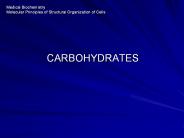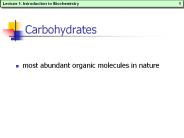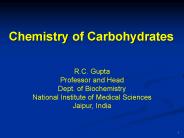Carbohydrates PowerPoint PPT Presentations
All Time
Recommended
Carbohydrates: Look for a 1:2:1 C:H:O ratio. Many carbohydrates will contain no P, N, or S. Lipids: Look for a 1:2 ratio of C:H and only very small amounts of O.
| PowerPoint PPT presentation | free to view
CARBOHYDRATES The simple Sugar and not so simple Starch By Valerie Shaw Can you live without sugar? Soda/Punch Cookies Candy Chocolate Desserts Sugary Cereals Ice ...
| PowerPoint PPT presentation | free to download
PowerPoint Presentation ... Carbohydrates
| PowerPoint PPT presentation | free to view
Medical Biochemistry Molecular Principles of Structural Organization of Cells CARBOHYDRATES CARBOHYDRATES Are hydrated carbon molecules [CnH2nOn or (CH2O)n ...
| PowerPoint PPT presentation | free to download
CARBOHYDRATES A Complex Story
| PowerPoint PPT presentation | free to view
Title: PowerPoint Presentation Author: Physician Assistant Studies Last modified by: pak eko Created Date: 3/29/2002 2:40:15 PM Document presentation format
| PowerPoint PPT presentation | free to download
PowerPoint Presentation ... Carbohydrates
| PowerPoint PPT presentation | free to download
CARBOHYDRATES General Information: Carbohydrates are the most abundant class of organic compounds found in living organisms. They originate as products of ...
| PowerPoint PPT presentation | free to download
carbohydrates chapter 5
| PowerPoint PPT presentation | free to view
CARBOHYDRATES Hydrated Carbon CARBOHYDRATES contain carbon, hydrogen, oxygen usually in ratio of 2 H : 1 O large chains and rings of carbon with different ...
| PowerPoint PPT presentation | free to view
CARBOHYDRATES Characteristics of Carbohydrates Consist of carbon, hydrogen, & oxygen Energy containing molecules Some provide structure Basic building block is a ...
| PowerPoint PPT presentation | free to view
Chapter 14 Carbohydrates Chapter 14 14.1 - Carbohydrates Chemistry of Life Carbohydrates are produced by photosynthesis in plants such as glucose are synthesized in ...
| PowerPoint PPT presentation | free to view
Iodine Role in body: Helps in metabolism as part of thyroid hormone Food Source: seafood, iodized salt Effects of deficiency: goiter (enlargement of thyroid), mental ...
| PowerPoint PPT presentation | free to view
Carbohydrates ( )x carbo - hydr ate CH2O(CH2O)x Function: Energy immediate and short term storage U Structural materials Monomer: sugars
| PowerPoint PPT presentation | free to download
Carbohydrates What are Carbohydrates? CHO make up 3% of the body s organic matter CHO are compounds constructed in a ratio of one atom of carbon and two atoms of ...
| PowerPoint PPT presentation | free to download
Title: Lecture 1. Introduction to Biochemistry Author: Hong Li Last modified by: Teacher Created Date: 8/1/2002 9:22:19 PM Document presentation format
| PowerPoint PPT presentation | free to download
Carbohydrates Created by T Stivers Schindewolf Intermediate Chapter 5 Day 2 Six Basic Nutrients Carbohydrates 2. Proteins 3. Fats 4. Vitamins 5.
| PowerPoint PPT presentation | free to view
Made from atoms of carbon (C), hydrogen (H) and oxygen (O) Examples are starch, glycogen (stored form of glucose) and sugars Carbohydrates are the body s primary ...
| PowerPoint PPT presentation | free to view
Carbohydrates Part 1 Type 1 diabetes Due to cellular-mediated autoimmune destruction of the cells of the pancreas, causing an absolute deficiency of insulin ...
| PowerPoint PPT presentation | free to view
... blood Complex carbohydrates Known as starches, fiber Made up of 100 s to 1000 s of simple sugars Found in grains, pastas, breads, cereals, ...
| PowerPoint PPT presentation | free to download
Title: PowerPoint Presentation Last modified by: tammy mercure Created Date: 1/1/1601 12:00:00 AM Document presentation format: On-screen Show (4:3)
| PowerPoint PPT presentation | free to view
Carbohydrates Chapter 18 Cyclic forms of monosaccharides We saw back in chapter 15 that glucose can form a cyclic hemiacetal. In fact, this form of glucose is more ...
| PowerPoint PPT presentation | free to download
Carbohydrates * Carbohydrates What is the first thing that comes to mind? Carbohydrates: Supply energy, vitamins, minerals, fiber and phytochemicals However, they are ...
| PowerPoint PPT presentation | free to download
Carbohydrates * Carbohydrates Most easily metabolized nutrient for the body, converted into glucose glucose provides energy for the brain and of energy for muscles ...
| PowerPoint PPT presentation | free to view
Carbohydrates Carbohydrates, one of the four major classes of biomolecules, are aldehyde or ketone compounds with multiple hydroxyl groups. They function as energy ...
| PowerPoint PPT presentation | free to view
To know the structures and names of some common carbohydrates. ... the case of resurrection plants, which can Jive in a dry state, when the water ...
| PowerPoint PPT presentation | free to view
CARBOHYDRATES By: Dr Norhasmah Sulaiman Department Of Resources Management And Consumer Studies Faculty Of Human Ecology UPM Chemist s View of Carbohydrates Dietary ...
| PowerPoint PPT presentation | free to view
Carbohydrates Disaccharides Polysaccharides Important Disaccharides Maltose = Glucose + Glucose Lactose = Glucose + Galactose Sucrose = Glucose + Fructose Maltose ...
| PowerPoint PPT presentation | free to download
... (human, bacterial); sweetness; absorption. Structural ... Measurement of optical activity in chiral or asymmetric molecules using plane polarized light ...
| PowerPoint PPT presentation | free to view
Carbohydrates. I make a concerted effort to eat 5 or more fruits ... Which of the following is used to sweeten some chewing gums and has cariostatic properties? ...
| PowerPoint PPT presentation | free to view
CARBOHYDRATES By: Dr Norhasmah Sulaiman Department Of Resources Management And Consumer Studies Faculty Of Human Ecology UPM Chemist s View of Carbohydrates Dietary ...
| PowerPoint PPT presentation | free to view
Carbohydrates Carbohydrates (or saccharides) consist of only carbon, hydrogen and oxygen Carbohydrates come primarily from plants, however animals can also ...
| PowerPoint PPT presentation | free to view
Starch in high moisture and steam flaked grains more digestible in the rumen and the intestine. Fecal Output of CHOH Fractions Fraction A (Sugars): ...
| PowerPoint PPT presentation | free to view
* * * * * * * * * * * * * * * * * * * * * * * * * * * * * * * * * * * * * * * * * * * * * Figure 4.8: Glycogen and Starch Molecules Compared (Small Segments). Notice ...
| PowerPoint PPT presentation | free to download
The functions of carbohydrates are pointed out to the fullest in this post. Carbohydrates are one of the three basic nutrients present in meals and beverages.
| PowerPoint PPT presentation | free to download
If your diet does not contain enough carbohydrates to supply the body with ... DKA (diabetic ketoacidosis)- life threatening blood-chemical imbalance that ...
| PowerPoint PPT presentation | free to view
The number of chiral carbons present in a ketose is always one less than the ... Epimers = Two sugars that differ in configuration at only one chiral center ...
| PowerPoint PPT presentation | free to download
Carbohydrates Anna Drew with grateful acknowledgement for inspirational teaching received at The School of Pharmacy, University of London Uses green plants store ...
| PowerPoint PPT presentation | free to view
Carbohydrates. Carbohydrates (CHO) are compounds made up of carbon, hydrogen and oxygen. ... There are three ways to preserve fats to prevent oxidative rancidity. ...
| PowerPoint PPT presentation | free to view
Diagnosis of Diabetes Mellitus. Symptoms of diabetes mellitus. Polyuria. Polydipsia ... with a family history of diabetes, older age ( 40), obesity and ...
| PowerPoint PPT presentation | free to view
Stereoisomers arise when there is a chiral carbon. Chiral carbon- four different substituents bonded ... Epimers- differ in arrangement about one other chiral carbons. ...
| PowerPoint PPT presentation | free to view
Title: No Slide Title Author: Eugene J. Fenster Last modified by: user Created Date: 12/13/2003 9:06:08 PM Document presentation format: Affichage l' cran (4:3)
| PowerPoint PPT presentation | free to download
Definition, classification, isomerism, structure and properties of carbohydrates
| PowerPoint PPT presentation | free to download
Unbranched chains digest more slowly and raise blood glucose less than branched (glycemic index) ... Glycemic index. Method of classifying foods according to ...
| PowerPoint PPT presentation | free to view
Carbohydrates By Nurkhasanah, Ph.D. General characteristics the term carbohydrate is derived from the french: hydrate de carbone compounds composed of C, H, and O ...
| PowerPoint PPT presentation | free to download
A good-carb diet, not a low-carb one, is how Agatston describes South Beach ' ... South Beach Diet. http://www.southbeachdiet.com/sbd/publicsite/how-it-works/how-it ...
| PowerPoint PPT presentation | free to view
Aldoses (e.g., glucose) have an aldehyde group at one end. ... Pentoses and hexoses can form ring structures as the ketone or aldehyde reacts with a distal OH. ...
| PowerPoint PPT presentation | free to view
We are advised to choose plenty of whole foods like this... Low GI 55 pasta, whole grain bread. Not just about individual foods about your diet ...
| PowerPoint PPT presentation | free to view
Carbohydrates (Sugars) Organic compounds with a 2:1 ratio between the Hydrogen and Oxygen. (CH2O) Monosaccharides (simple sugars) C6H12O6 glucose, deoxyribose, and ...
| PowerPoint PPT presentation | free to download
... into simple sugars, complex carbs must be digested by the enzyme amylase. Amylase is secreted by the salivary glands, which empty into the mouth, and by ...
| PowerPoint PPT presentation | free to view
Nutritive sweeteners. Contain 4 kcal energy per gram ... Alternative Sweeteners. Acceptable Daily Intakes (ADI) ... Alternative Sweeteners. Health Disorders ...
| PowerPoint PPT presentation | free to view
Carbohydrates 'hydrated (H2O) carbon' Contain carbon, hydrogen, and oxygen. Their major function is to supply a source of cellular fuel for energy creation by the body ...
| PowerPoint PPT presentation | free to view
Carbohydrates are not just an important source of rapid energy production for living cells. They are also structure building blocks of cells and components of numerous ...
| PowerPoint PPT presentation | free to view
A chiral carbon atom has four different groups attached. Mirror Images ... D,L tells which of the two chiral isomers we are referring to. ...
| PowerPoint PPT presentation | free to view
Provide 52% of calories in American diet. Complex ... soybeans, kidney beans (starchy seeds) Vegetables. Starchy veggies: sweet & white potatoes, ...
| PowerPoint PPT presentation | free to view
























































